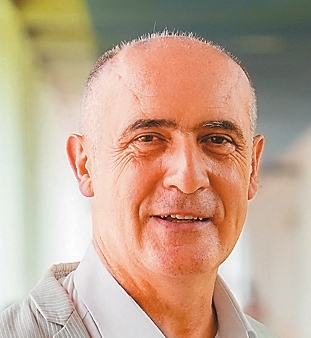
Chen Xiaochun 654789759@qq.com ERCAN ENGIN KURUOGLU, a renowned expert in information engineering and who is among the top 2% of the world’s most cited scientists, regards Shenzhen as a global leader in artificial intelligence (AI) technology application. “The AI industry in Shenzhen is now riding on the AI fast train, grasping every opportunity for application. That’s why it’s developing so fast. It is one of the leading cities in the world in terms of AI technology application,” Kuruoglu commented. The Turkish-Italian professor, formerly the chief scientist of the National Research Council of Italy, now serves as a full-time professor at the Institute of Data and Information at Tsinghua Shenzhen International Graduate School. Kuruoglu’s affinity for China dates back to his childhood when his sister introduced him to children’s books about the country. His fascination with China led to his first visit in 2006, where he forged a lasting friendship with a professor from Xi’an and discovered the country’s wonders for the very first time. “My sister used to bring me children’s books about China. The first book I ever read myself that I can remember was about China. It was a story of two Chinese twins living somewhere in Central China and their daily life,” he recalled. He visited Shenzhen for the first time in 2016 and decided to relocate to the city in 2019. “Why Shenzhen? Because Shenzhen is the world’s second Silicon Valley. Here, you can witness rapid progress; if you have an idea, you can see it implemented quickly, which might take much longer in Europe,” Kuruoglu explained regarding his decision to move to the city. Kuruoglu, who initially specialized in signal processing, has shifted his focus to AI. “Signal processing involves time series analysis, but at its core, it’s about information and data science. Today, we are deeply engrossed in discussions about artificial intelligence, even though true thinking machines do not yet exist. We have machines that excel at learning from data, a development that gained momentum about 10 years ago, significantly enhancing our data analysis methods,” Kuruoglu noted. The primary goal of his research is to develop methods for extracting concealed information from collected data. “We live in an era of big data that makes it so easy to generate or acquire information from our environment. We all have mobile phones; I personally use Xiaomi, which is my favorite. So, it’s very easy to take pictures and make videos, leading to a massive accumulation of data. Besides, we have so many sensors everywhere. The significance of artificial intelligence lies in a new method called deep learning, which provides us a new way to understand data,” Kuruoglu said. According to Kuruoglu, Chinese scientists have made significant contributions to the development of deep learning as they took a crucial step by applying it to speech data, which proved to be highly influential in advancing the field. “Perhaps the Chinese approach is highly application-oriented, and this is also what’s happening in Shenzhen. Shenzhen is one of the leading cities in the world in the application of AI technologies,” Kuruoglu acknowledged. The professor mentioned that some companies in Shenzhen are working on driverless cars, developing methods for teachers to interact with deaf children, as well as working on vision data such as facial recognition, and some labs are working on biological data, just to name a few. Kuruoglu’s research primarily addresses AI’s limitations, leveraging his expertise in signal processing for solutions. AI’s shortcomings include lack of generalization, data dependency, non-adaptive behavior, and high computational requirements. He develops statistical AI models, adaptive algorithms, and cost-effective deep learning architectures. His work also extends to remote sensing and the enhancement of satellite imagery analysis, tackling challenges like speckle noise and improving object detection. In the field of graph data analysis, he explores the dynamics and relationships of multivariate data, with applications in traffic analysis, cancer gene expression networks, and seismological networks for earthquake prediction. | 
